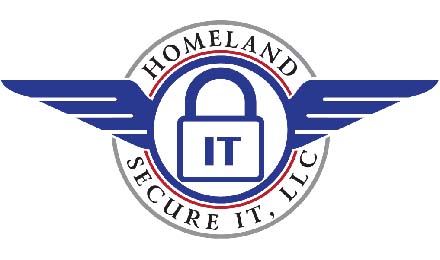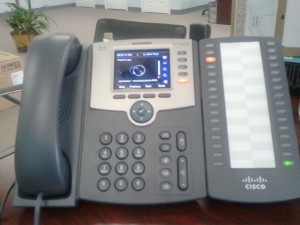One of the best selling phones for the small and medium business (SMB) market is the Cisco SPA525G2 phone. The entire series of SPA phones are affordable, reliable and well suited to SMB use, but the 525 G2 is the current big daddy with its color display, ability to play MP3s from a memory stick, sync to your cell phone via bluetooth, built-in bluetooth for wireless headset usage and so much more.
On every system we sell that includes the SPA 525, we get a few questions like, ‘How do you answer another extension?”, and of course we answer it, but, with such a long list of these “star codes”, I can’t remember them myself.
Cisco Star Codes for SPA525G2 Phones:
- Call Return (*69)—Calls the last caller, regardless which extension.
- Blind Transfer (*98)—Allows the user to transfer a call to another number without waiting for the other party to pick up.
- Call Back Act (*66)—Periodically redials the last busy number (every 30 seconds by default) until it rings or until the attempt expires (30 min by default), regardless which extension. Only one call back operation can be ordered at a time. A new order automatically cancels the previous order.
- Call Back Deact (*86)—Cancels the last call back operation.
- Call Forward All Act (*72)—Call forwards all inbound calls. Applies to primary extension only.
- Call Forward All Deact (*73)—Cancels call forward all. Applies to primary extension only.
- Call Forward Busy Act (*90)—Call forwards on busy. Applies to primary extension only.
- Call Forward Busy Deact (*91)—Cancels call forward on busy. Applies to primary extension only.
- Call Forward No Answer Act (*92)—Call forwards if no answer. Applies to primary extension only.
- Call Forward No Answer Deact (*93)—Cancels call forward no answer. Applies to primary extension only.
- CW Act (*56)—Enables call waiting. For example, if call waiting is turned off globally, this star code will turn on call waiting until the CW Deact code is entered.
- CW Deact (*57)—Deactivates call waiting. For example, if call waiting is turned on globally, this star code deactivates call waiting until the CW Act code is entered.
- CW Per Call Act (*71)—Enables call waiting for a single call. For example, if call waiting is turned off globally, this star code will turn on call waiting for that call.
- CW Per Call Deact (*70)—Deactivates call waiting for a single call. For example, if call waiting is turned on globally, this star code deactivates call waiting for that call.
- Block CID Act (*67)—Blocks caller ID on all outbound calls. Applies to all extensions.
- Block CID Deact (*68)—Deactivates caller ID blocking on outbound calls. Applies to all extensions.
- Block CID Per Call (*81)—Blocks caller ID on the next outbound call (on the current call appearance only).
- Block CID Per Call Deact (*82)—Deactivates caller ID blocking on the next outbound call (on the current call appearance only).
- Block ANC Act—Blocks anonymous calls. Applies to all extensions.
- Block ANC Deact—Deactivates anonymous call blocking. Applies to all extensions.
- DND Act (*78)—Activates Do Not Disturb. Applies to all extensions.
- DND Deact (*79)—Deactivates Do Not Disturb. Applies to all extensions.
- Secure All Call Act (*16)—Defaults to prefer to use encrypted media (voice codecs).
- Secure No Call Act (*17)—Defaults to prefer to use unencrypted media for all outbound calls. Applies to all extensions.
- Secure One Call Act (*18)—Prefers to use encrypted media for the outbound call (on this call appearance only).
- Secure One Call Deact (*19)—Prefers to use unencrypted media for the outbound call (on this call appearance only).
- Paging (*96)—Pages the number called.
- Call Park (*38)—Parks a call on an entered line number.
- Call UnPark Code (*39)—Retrieves a call from an entered line number.
- Call Pickup (*36)—Picks up a call at an entered extension.
- Group Call Pickup (*37)—Picks up a ringing call at a group of extensions.
- Media Loopback Code (*03)—A service provider can set up a test call from an IP media loopback server (the source) to a subscriber’s VoIP device (the mirror). The test call provides statistical reporting on network performance and audio quality.
Depending on the source’s capabilities, the SP can see packet jitter, loss, and delay (although Media Loopback cannot identify an offending hop). This helps the SP identify an offending hop that could be causing issues in VoIP calls to a subscriber. The test results can also provide audio quality scoring, which lets a SP better understand the subscriber’s experience.
Referral Services Codes—One or more * codes can be configured into this parameter, such as *98, or *97|*98|*123, and so on. The maximum total length is 79 characters.
This parameter applies when the user places the current call on hold (by Hook Flash) and is listening to second dial tone. Each * code (and the following valid target number according to current dial plan) entered on the second dial-tone triggers the Cisco IP phone to perform a blind transfer to a target number that is prepended by the service * code. For example:
a. After the user dials *98, the Cisco IP phone plays a special prompt tone while waiting for the user the enter a target number (which is validated according to the dial plan as in normal dialing).
b. When a complete number is entered, the Cisco IP phone sends a blind REFER to the holding party with the Refer-To target equals to *98 target_number. This feature allows the Cisco IP phone to hand off a call to an application server to perform further processing, such as call park. The * codes should not conflict with any of the other vertical service codes internally processed by the Cisco IP phone. You can delete any * code that you do not want the call server to process.
Feature Dial Services Codes: Tells the Cisco IP phone what to do when the user is listening to the first or second dial tone.
You can configure one or more * codes into this parameter, such as *72, or *72|*74|*67|*82, and so on. The maximum total length is 79 characters. When the user has a dial tone (first or second dial tone), they can enter a * code (and the following target number according to current dial plan) to trigger the Cisco IP phone to call the target number prepended by the * code. For example:
a. After the user dials *72, the Cisco IP phone plays a special prompt tone while waiting for the user the enter a target number (which is validated according to the dial plan as in normal dialing).
b. When a complete number is entered, the Cisco IP phone sends an INVITE to *72 target_number as in a normal call. This feature allows the proxy to process features such as call forward (*72) or BLock Caller ID (*67).
You can add a parameter to each * code in Features Dial Services Codes to indicate what tone to play after the * code is entered, such as *72‘c‘|*67‘p‘.
Following is a list of allowed dial tone parameters (note the use of back quotes surrounding the parameter without spaces).
- ‘c‘ = Cfwd dial tone
- ‘d‘ = Dial tone
- ‘m‘ = MWI dial tone
- ‘o‘ = Outside dial tone
- ‘p‘ = Prompt dial tone
- ‘s‘ = Second dial tone
- ‘x‘ = No tones are place, x is any digit not used above
If no tone parameter is specified, the Cisco IP phone plays the prompt tone by default.
If the * code is not to be followed by a phone number, such as *73 to cancel call forwarding, do not include it in this parameter. In that case, add that * code in the dial plan.
Homeland Secure IT is happy to be a Cisco SMB Select Partner! If we can provide your business VoIP support in the Greenville / Upstate, SC area, please call upon us at 864.990.4748 or email info@homelandsecureit.com

